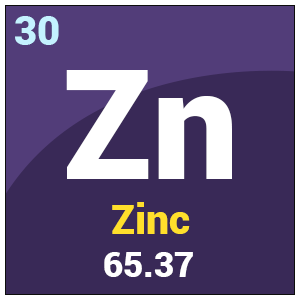
| Symbol | Zn |
| Atomic Number | 30 |
| Atomic Mass | 65.37 g.mol−1 |
| Discovered by | Andreas Marggraf |
Chemical Properties of Zinc
| Group | 12 | Melting point | 419.527°C, 787.149°F, 692.677 K |
| Period | 4 | Boiling point | 907°C, 1665°F, 1180 K |
| Block | d | Density (g cm−3) | 7.134 |
| Atomic number | 30 | Relative atomic mass | 65.38 |
| State at 20°C | Solid | Key isotopes | 64Zn |
| Electron configuration | [Ar] 3d104s2 | CAS number | 7440-66-6 |
| ChemSpider ID | 22430 | ChemSpider is a free chemical structure database | |
What is Zinc?
- Zinc is a transition earth metal with atomic number 30 and represented in the Periodic Table with the symbol ‘Zn’
- Zinc is one more of those advantageous metals that we make use of daily.
- It is part of those elements which humans have been expanding for thousands of years.
Zinc is an important trace element in the human body, where it is present as an integral part of the enzyme carbonic anhydrase at high concentration in the red blood cells, causing several reactions related to carbon dioxide metabolism.
Uses of Zinc
- The metal is used for manufacturing like creating roofing materials or making zinc oxide.
- The metallic element is used for various purposes ranging from sunscreens to solar cells to nuclear reactors.
- The metal helps in maintaining the balance of enzymes in the human body.
- It is used as a white pigment for oil-based paints.
- Another important use of zinc oxide is as an additive to the rubber used to make automobile tires.
- Zinc oxide can withstand high temperatures and it prevents the tires from breaking apart when they get hot.
- Freshly cast zinc has a bluish silver surface but slowly oxidizes in air to form a film of grayish protective oxides. Highly pure zinc (99.99 percent) is ductile; the so-called prime western grade (99.8 percent pure) is brittle when cold but can be rolled over 100 ° C (212 ° F) into flexible sheets. The zinc crystallizes in the tightly packed hexagonal form.
List of Zinc Uses
Zinc is widely used in the die casting industry. At present, zinc is the world’s fourth most widely consumed metal after iron, aluminum and copper. It has strong anti-corrosive properties and is well connected to other metals. Accordingly, about half of the zinc produced is used in galvanizing zinc, which is the method of applying thin layers of zinc to iron or steel to avoid rusting.
The next leading use of zinc is as an alloy; the zinc is mixed with copper (to form brass) and other metals to form materials used in vehicles, electrical parts, and household appliances. A third significant use of zinc is in the production of zinc oxide (the most important zinc chemical by volume of production), which is used as a protective skin ointment in rubber manufacture.
Zinc is essential to health, as well. It is a critical element to proper human, animal , and plant growth and development. The adult human body contains between 2 and 3 grams of zinc which is the amount required for proper functioning of the body’s enzymes and immune system.
Physical Properties of Zinc
- Zinc is generally seen as part of larger compound minerals.
- When secluded, it is a very sparkly, whitish-blue metal.
- The metal is not as soft as copper and has lesser uses.
Certain Facts about Zinc
- In 1746, Marggraf secluded and defined zinc as a distinct metal.
- In the fourth period or row in the periodic table of elements, zinc is the last transition element.
- Large doses of zinc, especially when taken on an empty stomach, can cause nausea and other forms of gastrointestinal upset. Large doses of zinc can also induce a deficiency of copper and lead to overdose.
- Many supplements use much more than the RDA, and a combination of supplements, fortified foods, and high zinc foods can result in exceeding the adults’ tolerable upper intake level of 40 mg per day.
- Childhood zinc deficiency can hurt growth. Zinc deficiency in adults can lead to hypogonadism in men, as well as mental lethargy, depression and defects in the skin.
Recommended Videos

Frequently Asked Questions – FAQs
What are the benefits of taking zinc?
Zinc, a mineral found in your body, facilitates the functioning of your immune system and metabolism. Zinc is also important for healing wounds, and for your sense of taste and smell. Your body typically gets enough zinc over a varied diet.
What are the disadvantages of zinc?
Just as a zinc deficiency can cause complications for health, excessive intake can also lead to negative side effects. So much added zinc is the most common cause of zinc toxicity, which can cause both acute and chronic symptoms. Toxicity signs include: nausea and vomiting.
What is zinc used for?
Zinc is needed to keep the human body growing and maintaining properly. It’s present in multiple systems and biological reactions and is required for immune function, wound healing, blood clotting, thyroid function, and more.
Why does zinc have a low melting point?
Iron has filled the d orbital in an incomplete way while Zn has filled d-orbital in full. Regardless of the screening effect, the size of Zn is much greater than that of Fe, which means that Zn’s valence electrons are less confined to the nucleus than that of Fe.
Does Zinc rust in water?
Zinc corrodes when exposed to air and water as with all ferrous metals. Zinc, however, corrodes on steel at a rate of 1/30 of that. Like other ferrous metals, zinc corrodes or rusts at different levels, depending on their environment.
Visit Byjus to learn more about chemical elements.


Comments